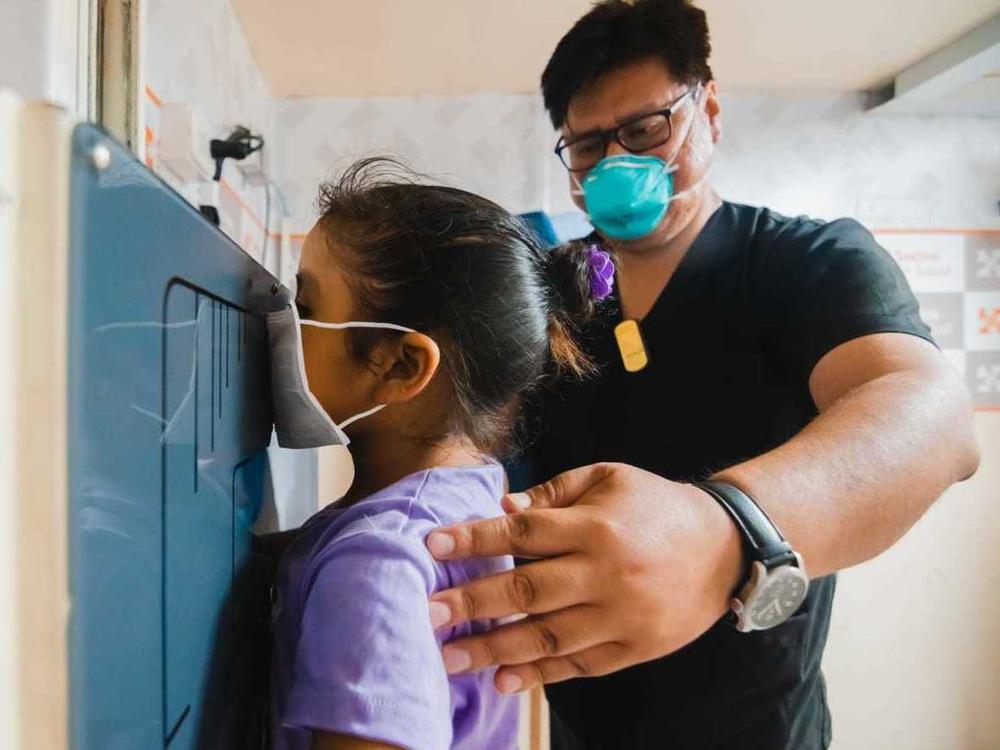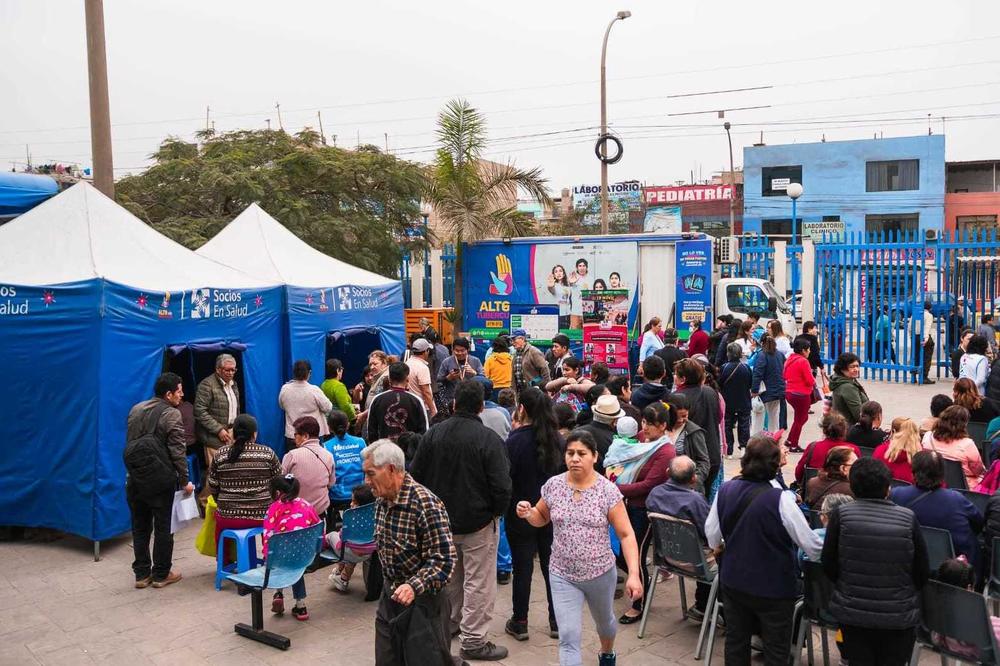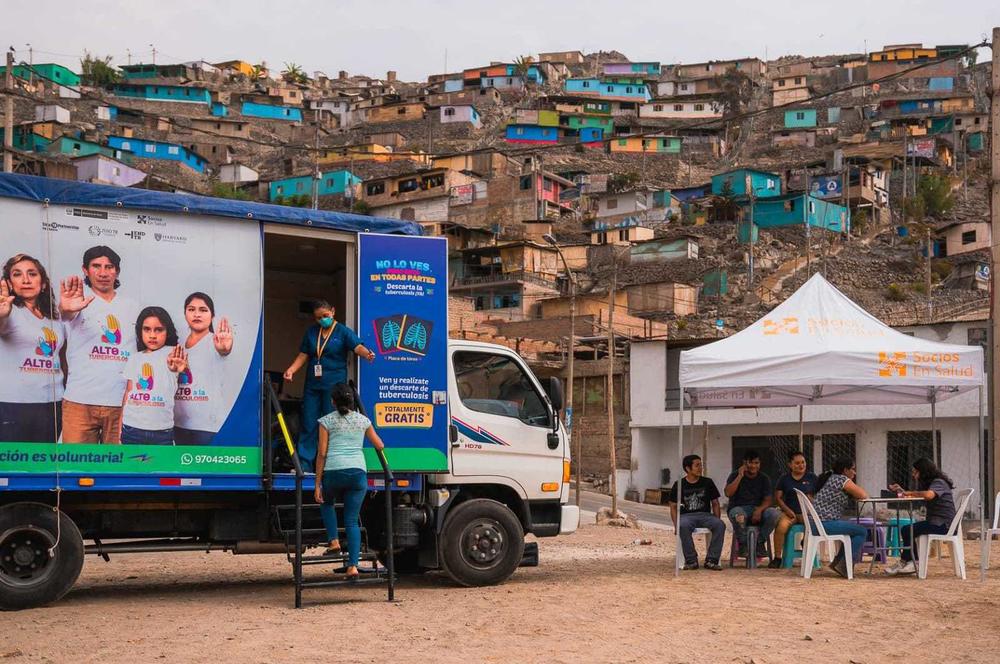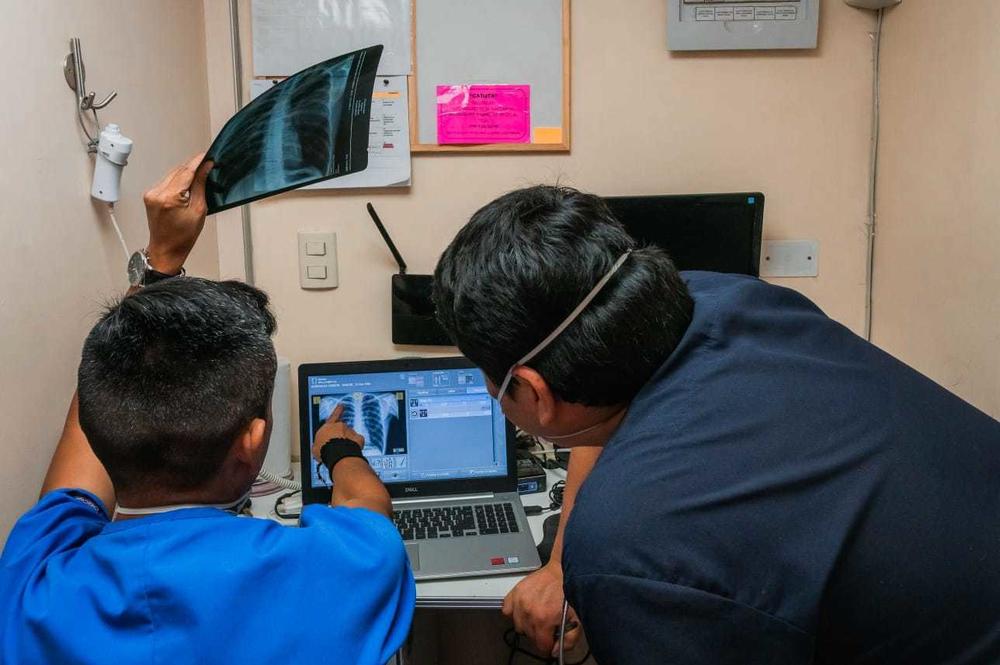Section Branding
Header Content
An Unexpected Pandemic Side Effect In Peru: A Comeback For TB
Primary Content
In late February 2020, Martin Valencia Garcia was working as a community agent in Independencia, one of the denser districts of Lima, Peru. His job was to help people access tuberculosis diagnosis and treatment with the TB Móvil program, part of a larger effort led by the nonprofit health care organization Partners in Health to drastically reduce TB rates in Lima's at-risk communities. TB, which most commonly affects the lungs, is one of the deadliest infectious diseases in the world, and Peru, according to data from 2017, has the highest rate of drug-resistant TB in the Americas.
While working, Valencia Garcia met a 52-year-old man with a cough and invited him to get a scan at the TB Móvil van visiting his neighborhood, one of two in the city with an X-ray machine and artificial intelligence technology. The man's results indicated he needed further tests and treatment, but not long after, the whole country was on lockdown due to COVID-19. Tuberculosis services were limited, and Valencia Garcia suspects the man got tired of waiting. "He could not do the exams, and since he couldn't do the exams, he couldn't be diagnosed and he couldn't receive treatment," says Valencia Garcia. Many people have experienced the same, he adds. Though he was in charge of the man's case, Valencia Garcia says he lost contact with him in late April. As far as he knows, the man was never diagnosed or treated.
Tuberculosis kills around 1.5 million people a year, making it a top priority for public health organizations. The United Nations aims to end the epidemic of tuberculosis by 2030, but COVID-related disruptions to TB treatments may push that goal out of reach — and end up propagating strains that are resistant to treatment, which also tend to be the deadliest.
"Many people have undetected cases or have stopped coming to receive their treatment" due to the pandemic, says Luz Villa-Castillo, a study coordinator at Cayetano Heredia University in Lima. The resulting lack of diagnostic testing and inconsistent treatment is masking a rising tuberculosis caseload, doctors fear. Patients who have started antibiotics may not have the right medications to continue treatment, which means they "have likely become resistant," Villa-Castillo says, "because they have let a lot of time pass without going to the health center."
COVID-19 has overwhelmed health-care systems and disrupted TB care all over the world. Peru in particular has struggled to secure sufficient personal protective equipment and continue medical services during the pandemic. "Public health systems in most countries have not made adequate adjustments to care for people with TB in the context of COVID," says Carole Mitnick, a professor of global health and social medicine at Harvard Medical School. Unless major changes occur, she adds, "we're going to see the effects of this pandemic for generations."
A three-month lockdown followed by a 10-month restoration period [of TB services] could result in an additional 6.3 million cases and an additional 1.4 million deaths worldwide in the next five years, according to research from the Stop TB Partnership, an international body coordinating the fight against the disease. In light of those dismal projections, some countries are looking for new ways to combat TB. Peru's Ministry of Health and Partners in Health plan to add to the fleet of TB Móvil units, for example, and lean more expansively into the AI-driven diagnostic tools they carry.
Whether such projects will be enough to stave off a flood of TB cases remains to be seen. "We never learn from mistakes," warned Lucica Ditiu, the executive director of the Stop TB Partnership, which works with 1,700 groups focused on eliminating tuberculosis worldwide, in a recent report. Over the past five years, TB has remained one of the deadliest infectious diseases because it wasn't given priority, she continued. "Today, governments face a torturous path, navigating between the imminent disaster of COVID-19 and the long-running plague of TB. But choosing to ignore TB again would erase at least half a decade of hard-earned progress."
How exactly does tuberculosis spread?
Tuberculosis is caused by a bacteria. Like the COVID-19 virus, TB spreads through the air in tiny droplets after someone with an active infection sneezes or coughs; from there, it typically lodges in the lungs and can spread into the kidney, spine, and brain. One in four people are estimated to have tuberculosis worldwide, but in most cases, the bacteria remains dormant with no risk of transmission. The roughly 5 to 10% of cases that become active lead to chronic cough, fatigue, fever and even organ failure.
These active cases are highly infectious. According to the World Health Organization, a single person with an active, untreated TB infection can infect between five and 15 people per year. Over 95% of cases are in lower income countries. People with HIV or otherwise compromised immune systems are at particularly high risk of active infection. If left untreated, almost half of people who are HIV-negative, and nearly all people who are HIV-positive, will die from TB.
Drug-resistant TB cases are on the rise
Chest X-rays are frequently used to identify possible active tuberculosis infections. If the scan shows abnormalities in the lungs, the patient may have damage due to a TB infection. To confirm the infection, health practitioners take a sputum sample — phlegm that the patient coughs up — and analyze it for tuberculosis bacteria. Then, further diagnostic tests reveal if the bacteria is resistant to drugs. Villa-Castillo has seen long delays in the arrival of these diagnostic tests due to the pandemic and explains that the testing equipment is critical "because then you can quickly start the type of treatment specific to the strength of the bacteria."
While tuberculosis is treatable, an increasing number of cases — about 3% of new cases and 18% of existing ones — are drug-resistant. While a combination of drugs kills most TB bacteria after about six months, patients with drug-resistant TB require intensive treatment for up to two years. The longer treatments are more expensive and often toxic. Only about 60% of people with multi-drug resistance and 40% of those with extensive drug-resistance survive.
Even before the COVID-19 pandemic, drug-resistant TB treatment rates were low. In 2018, of the nearly 500,000 new cases, only a third were given an effective treatment. A study of TB in India, Kenya and Ukraine by the Stop TB Partnership estimates that completion rates for second-line treatments — meaning the second attempt after a first drug has failed — for drug-resistant TB will drop as low as 25% in those countries due to COVID-related disruptions. Incomplete or incorrect treatment can make the bacteria even harder to kill as the stronger strains survive and infect more people.
COVID-19 has complicated matters. Due to disruptions in health systems around the world, TB case notification declined by 75 to 80% in India, China, and Pakistan over the summer of 2020. A Stop TB Partnership survey of the top 20 high-burden TB countries in the world found that staff, isolation wards and specialists are frequently being redirected to COVID-19 care; many TB laboratories and research teams have been shut down; and some TB diagnostic supplies and drug shipments have been disrupted.
"It's nothing short of absolutely devastating," says Mitnick. "More and more people are getting sick and fewer people are having access to care."
While some might hope that COVID precautions could reduce TB transmission, Mitnick is skeptical. "Any benefit would be enormously outweighed by the reality that TB, unlike COVID, is transmitted through sustained, long-term contact." Few people wear masks or socially distance at home with their close contacts, so these protections will have little impact, she says.
Research from the London School of Hygiene and Tropical Medicine also predicts an increase in both TB cases and deaths regardless of social distancing in low- and middle-income settings. In the worst-case scenario, they estimate an additional 200,000 TB deaths from China, India and South Africa alone. And research from Imperial College London predicts a 20% increase in deaths in high-burden countries over the next five years due to delayed TB diagnosis and treatment.
While such research rarely takes drug resistance into account, health service decline is likely to have the greatest impact on patients with drug-resistant tuberculosis. These cases require persistent oversight by doctors and long-term medication. Disruptions in drug availability and fear of clinic visits cause erratic TB management, which is a recipe for treatment failure and amplification of drug resistance.
A fleet of vans bring TB tests, treatment to the people
Peru's overall tuberculosis rates have been in steady decline for the past 10 years. During the COVID-19 pandemic, reported TB cases have continued to decrease, but doctors suspect a hidden resurgence in TB, because patients have stopped coming in to the clinic to be diagnosed and treated.
"The amount of TB reported has gone down," says Salmaan Keshavjee, director of the Harvard Medical School Center for Global Health Delivery--Dubai, but "presumably the amount of TB circulating in the communities has not. So that would suggest that there is more untreated TB out there."
Peru's approach in providing patients with mobile care has been successful in detecting and treating TB in other countries, including Pakistan, Nigeria and Zimbabwe. The vans are equipped with X-ray machines, computers enhanced with artificial intelligence to read scans and diagnostic tests for follow-up. The software uses deep learning to detect abnormalities in the chest X-rays and then creates a heat map of suspicious areas in the lungs and provides a score, from 0 to 100, that suggests the likelihood of an infection.
"If the score is very high ... that person has more risk of tuberculosis," so they perform a diagnostic test, says Leonid Lecca, the executive director of Partners in Health in Peru. "If the score is under 60, we consider the X-ray normal."
"It makes it much easier to screen large populations of people," says Keshavjee. Using this AI-enhanced technology helps triage patients, reduce demand on radiologists, and make more efficient use of TB testing supplies. In a comparison between radiologists and AI machines, researchers suggest that the AI-enhanced readings perform as well as human readers, catching 90% of cases.
This technique "will increase the reach, access and efficiency in providing critical services to all those in need, especially now," during the pandemic, states Ditiu of the Stop TB, in a press release.
But artificial intelligence readings have limitations. These systems are not able to provide insight into drug resistance, because the X-rays reveal lung damage regardless of the strength of the bacteria. The cutoff point for TB suspicion also may vary, because X-ray features are dependent on a patient's age, immune status and prior TB exposure. "The threshold for that is different in different populations and that can affect the sensitivity" of the machine, says Amyn Malik, an infectious disease epidemiologist at the Yale Institute for Global Health. Additionally, scanning is limited by COVID physical distancing precautions, so the number of people scanned per day by each truck been cut in half since the pandemic began.
In addition to adding to the fleet of mobile TB units, the government also plans to test patients for COVID from the vans, says Lecca, which could enhance the impact of the TB Móvil project. Lecca hopes the government will implement a household contact tracing system for TB to prevent spread too. The TB Móvil model could facilitate community mapping of TB cases and help distribute medication that protects exposed individuals from developing the disease.
"If we use this opportunity to dramatically increase uptake of preventative therapy for TB," says Mitnick, "that could mitigate a lot of the long-term effects of the pandemic." However, she adds, "no single solution is going to solve all of our problems."
This story originally appeared in Undark, a non-profit, editorially independent digital magazine exploring the intersection of science and society. Robin Blades is a freelance science journalist and a clinical researcher at the University of California, San Francisco.
Copyright 2021 Undark Magazine. To see more, visit Undark Magazine.





